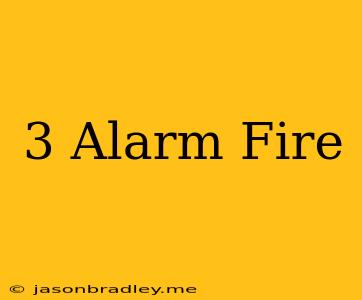What is a Three-Alarm Fire?
A three-alarm fire is a large and serious fire that requires a significant response from the fire department. It typically involves multiple fire engines, ladder trucks, and other support vehicles, along with additional personnel to effectively combat the blaze. The term "alarm" in this context refers to the escalation of resources deployed to the fire scene.
How it works:
- First Alarm: When a fire is reported, the initial response usually involves one or two fire engines and a ladder truck. This is a "first alarm" response.
- Second Alarm: If the fire is deemed more serious, a "second alarm" is called, bringing in additional resources like more engines, trucks, and possibly specialized equipment like an aerial ladder.
- Third Alarm: A "third alarm" signifies a major fire that requires a significant deployment of resources. This could include multiple fire stations, fire chief presence, and possibly mutual aid from neighboring fire departments.
Why a Three-Alarm Fire is serious:
A three-alarm fire often indicates a large-scale fire that poses several challenges:
- Size and Intensity: The fire is likely to be extensive, covering a large area or multiple buildings.
- Structural Integrity: The fire could compromise the structural integrity of buildings, posing a risk of collapse.
- Danger to Firefighters: The intensity and size of the fire make it more dangerous for firefighters to operate, requiring specialized equipment and tactics.
- Impact on the Community: A major fire can cause significant disruption to the community, affecting traffic, businesses, and residents.
Examples of Three-Alarm Fires:
Three-alarm fires can be caused by various factors, including:
- Large-scale Structure Fires: Fires in industrial buildings, warehouses, or large apartment complexes.
- Wildfires: Out-of-control wildfires that threaten significant property and human lives.
- Multi-Building Fires: Fires that spread from one building to another, creating a larger and more dangerous situation.
Safety Measures:
It's important to take precautions to prevent fires and stay safe during fire emergencies:
- Smoke Alarms: Install working smoke alarms in your home and test them regularly.
- Fire Extinguishers: Have fire extinguishers readily available and know how to use them.
- Escape Plan: Develop a fire escape plan for your family and practice it regularly.
- Emergency Contact Information: Keep important contact information, including emergency services numbers, readily accessible.
A three-alarm fire is a serious event that requires a significant response from firefighters. By understanding the factors that contribute to these fires and taking necessary safety precautions, we can minimize the risk of fire emergencies and protect ourselves and our communities.
